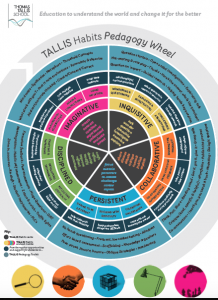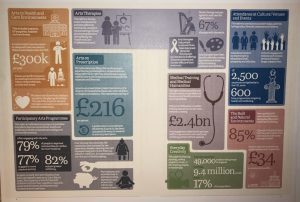As I was absent on Tuesday 26th September, there will be no blog post for week 3.
Childhood Development in the Arts & Visual Music
Art
We were given the opportunity to examine and analyse a range of children’s artwork, some of which dated back to around 25 years ago. Each artwork was categorised into 3 stages of education – early, middle and upper. There were considerable differences between all the levels, which conveyed each child’s artistic boundaries at the point of creating their artwork.
The main reading I referred to in this session was Teaching Art and Design 3-11 (2007), which talks of how Lowenfield and Brittain (1987) largely contributed to stage theory in art education. They identified key stages in a child’s development: scribbling, pre-schematic, schematic, gang stage. As much the work of these scholars can help me, as a teacher, to understand where a pupil is at in their creative development, I feel it is not be as simple as categorising their work, as each child is unique in their own abilities. If educators solely practiced teaching art using the work of Lowenfield and Brittain, they would correspond progression with chronological age (Green and Mitchell 1997, cited in McAuliffe, 2007), thus creating limitations and restricting a child’s ability to fully express themselves.

It is evident this piece artwork has came from a child at an early stage of art development as it may be unclear to an adult to make sense of what the child has tried to represent. This may be identified as in the “scribbling stage” of a child’s development in art and design. However I could personally identify the artist of the picture as a young child as I can see development of skills within identifying shapes, colours and textures. The child has predominately used primary colours but also moderately uses secondary colours, this could mean they are beginning to develop early levels of art and design, highlighting some of the Expressive Arts learning benchmarks (Education Scotland, 2017). In reflection, from analysing many pieces of artwork, I realise the most important steps I can take to develop a child’s creativity and art skills is to consistently build on their confidence. I can do this by showing clear positivity and interest to their artwork and ask them what they have tried to create, rather than influencing them to tell me what I interpret the picture to be. This will build on their imagination and free them from the restrictions of adult expectations (Duffy, 2006), because after all, art has many interpretations and does not have a right or wrong answer.
This picture would most likely fall under the “schematic” stage at around 7-9 years old. This is probably the most important stage in a child’s development, as this is when their imaginative development has peaked and it does occur to them how their work will be judged; fear of opinions is mainly dealt with more during the “gang” stage. I analysed more pictures that was created in the later primary years. These were very talented pieces of artwork, however nearly all of them were inspired by other infamous artists such as Picaso and Andy Warhol. This concept of plagiarism seems to emerge as children feel more inclined to copy other praised artists in order to be deemed ‘competent’ in their art skills. As a potential primary teacher I feel this is the wrong way to allow children to express themselves freely and explore their imaginations. This is why the previous stage of “schematic” may be crucial because we as teachers must show them there is no boundaries in individual artistry, before they reach a stage where there is a decline in their creativity.
Music
In the first music input of the module, the main task we were given to listen to a piece of music and to create a story to fit how we visualised the music. The video can found through this link – https://www.youtube.com/watch?v=gFanayBhyeA.
The main point I took from this session was that, alike many other expressive art areas, there is a vast difference in people’s interpretations and perceptions of music. This is due to people having different experiences and perspectives of the world that surrounds them. After listening to the short piece of music, my group decided to create a story about two fish set off on a journey full of both happy and dangerous moments. We creating six drawings on a story board to convey certain situations depending on the mood of the music. For example, when there were a loud crescendo we decided to bring in an evil shark that would frighten and put the fish at risk.

In relation to planning and teaching, I found this concept of integrating literacy very interesting as it made the whole activity enjoyable and very adaptable for children. It being a cross-curricular activity I found it very beneficial as it opened up a lot of new ideas for planning lessons, depending on which level I find myself teaching.
References
Duffy, B. (2006) Supporting Creativity and Imagination in the Early Years. Maidenhead: Open University Press.
Education Scotland (2017) Benchmarks Expressive Arts. [Online] Available: https://education.gov.scot/improvement/Documents/ExpressiveArtsBenchmarksPDF.pdf [Accessed 21 September 2017].
McAuliffe, D. (2007) Foundation and Primary Settings. In Teaching Art and Design 3-11. (Edited by Sue Cox, Robert Watts, Judy Grahame, Steve Herne and Diarmuid McAuliffe) London: Continuum.
Shostakovich, D. (1957) Piano Concerto No. 2. [Online] Available: https://www.youtube.com/watch?v=gFanayBhyeA. [Accessed 21 September 2017].
Introduction to Integrated Arts
As I made my way into the first lecture of Integrated Arts, it is fair to say I was feeling fairly pessimistic and anxious . After having both good and bad experiences in my prior education in the arts, I was worried that I would not be “talented” enough to excel in this class. However, I have learned the main aim of this module is to allow us, as both students and teachers, to reconstruct our attitudes to teaching the arts and broaden our experiences in expressive arts areas, rather than solely attempting to enhance our own creative skills.
We were introduced to various academic readings related to the creative arts. One of which was the Tallis Habits Pedagogy Wheel (Thomas Tallis School, 2017). This gives us an insight into how to develop and implement the arts  throughout the school curriculum through encouraging a number of habits, such as being imaginative, inquisitive, collaborative and persistent. The outer segments of the wheel relate specifically to strategies teachers can employ that enable students to deliberately strengthen their habits of mind. I felt this was particularly useful to me, as an aspiring teacher, because it highlights how complex yet valuable teaching the arts and nurturing learners’ creativity are. I appreciate that pedagogy of more traditional subjects, such as literacy and mathematics, have various methods and strategies however I feel the intricacy of teaching in the arts really challenges an educator’s commitment to not only discover a learner’s talents and strengths but also their own.
throughout the school curriculum through encouraging a number of habits, such as being imaginative, inquisitive, collaborative and persistent. The outer segments of the wheel relate specifically to strategies teachers can employ that enable students to deliberately strengthen their habits of mind. I felt this was particularly useful to me, as an aspiring teacher, because it highlights how complex yet valuable teaching the arts and nurturing learners’ creativity are. I appreciate that pedagogy of more traditional subjects, such as literacy and mathematics, have various methods and strategies however I feel the intricacy of teaching in the arts really challenges an educator’s commitment to not only discover a learner’s talents and strengths but also their own.
We were also introduced to a report called Creative Health: The Arts for Health and Wellbeing (2014). This report explains how powerful the contribution of the arts has on health and well being. It suggests that the arts can help keep u s well, aid our recovery and support longer lives better lived and also help meet major challenges facing health and social care. Before reading this report, my understanding of how significantly the arts impact on the lives of people was limited. My prior understanding was that participation in the arts was merely a hobby and something that people did not necessarily need to develop their academic growth or maintain their heath. I now realise that is not the case and I understand how important learning in and through the arts really is.
s well, aid our recovery and support longer lives better lived and also help meet major challenges facing health and social care. Before reading this report, my understanding of how significantly the arts impact on the lives of people was limited. My prior understanding was that participation in the arts was merely a hobby and something that people did not necessarily need to develop their academic growth or maintain their heath. I now realise that is not the case and I understand how important learning in and through the arts really is.
I now feel I have a strong foundation of knowledge to begin my learning in the Integrated Arts module. Also, it has now been made clear to me that teaching the expressive arts is not about how well you can paint, or act, or dance, or sing. It is about giving every child an opportunity to learn in different ways and it does not necessarily matter how advanced your skills are or how experienced you are in the expressive arts. I look forward to experiencing what else the Integrated Arts module has in store.
References
Thomas Tallis School. (2017) The TALLIS Habits Pedagogy Wheel. [Online] Available: http://www.thomastallisschool.com/tallis-pedagogy-wheel-guide.html [Accessed 12 September 2017].
The All-Party Parliamentary Group on Arts, Health and Wellbeing (2014) Creative Health: The Arts for Health and Wellbeing. [Online] Available: http://www.artshealthandwellbeing.org.uk/appg-inquiry/Publications/Creative_Health_The_Short_Report.pdf [Accessed 12 September 2017].


